Nutritional Information
From applesauce to apple butter and apple jelly, apples are such a versatile fruit and jam-packed with nutrients that are beneficial to your baby.
- Good source of fiber, which benefits heart health and digestion. The pectin in apples is a prebiotic, which is the food probiotics, or good bacteria in the gut, feed on. The soluble fiber apples contain helps with cholesterol levels.
- Helps with hydration due to their high water content.
- Good source of vitamin C, which helps with immunity.
- The antioxidants in apples help with cancer prevention.
Apple Tip: Different types of apples will have different nutrition profiles but they all are nutritious so choose whichever ones you enjoy. The skin contains most of the nutrients so try to leave some of it on if your baby can handle it. For baby's first purees and finger foods, we would recommend starting with sweeter apples such as Pink Lady or McIntosh, Honeycrisp, Fuji, Jazz or Kanzi apples, as apposed to the tart variety.
When can you introduce apples to your baby?
Are apples a choking hazard to your baby?
Are apples a common allergen?
Do apples cause constipation for babies?
How to Serve Apples
Apples are a great first food for babies and a healthy snack for toddlers, as long as you prepare or cut the apple in an age-appropriate way. Always make sure the seeds are removed and for younger babies, serve soft cooked or pureed apples to minimize choking risks.
6+ Months
See below for these recipes.
Apple Puree
Self-Feeding: Baby-Led Weaning
- Apple for Baby-Led Weaning: Cooked halves or whole (without skin), or as a puree
7+ Months
Stage Two Purees
9+ Months
Stage Three Purees
Self-Feeding: Finger Foods
- Apple for Self Feeding: Cooked halves or whole (without skin), grated or thin slices (with or without skin), as a puree
12-36 Months
Toddler Recipes
Recipes
Apple Puree
Prep Time: 5 minutes
Cook Time: 15 minutes
Servings: 20 ounces
Age: 6+ months
Ingredients
- 6 apples, peeled, cored and chopped
- 1/2 cup water
- 1/4 teaspoon cinnamon (optional)
Instructions
-
Add: In a medium saucepan, place the apples, water and cinnamon.
-
Cook: Cover and heat on medium-low for 10-15 minutes or until apples are tender. Let cool slightly.
-
Transfer: Transfer all of the ingredients into a blender or food processor.
-
Puree: blend on medium for 1-2 minutes or until completely smooth. For a chunky puree, quickly pulse the ingredients 10-15 times or until you receive your desired consistency.
-
Eat: Serve to your baby or freeze for later.
Notes
Age: 6 months and up
Yield: roughly 20 ounces
Additional Spices: Feel free to sub in these spices instead of the cinnamon for this recipe – pinch of cloves, nutmeg, ginger powder, coriander, 1-2 leaves of fresh mint, 1-2 leaves of fresh basil, or a pinch of freshly grated ginger.
Apples: you can use any sweet apple in this recipe – Gala, Honeycrisp, Fuji, McIntosh, etc.
Apples for Self Feeding
Apples are a good food for your baby to self-feed, whether for baby-led weaning, which happens around 6 months of age, or during the finger foods stage at 9 months.
Cooked Halves or Whole (6+ months): It’s best to start your baby with a either a half or whole apple, without the skin - peeled, that has been steamed until tender. You can also serve your baby a puree on a self-feeding spoon.
Grated or Thin Slices (9+ months): when your baby’s pincer grasp has developed, you can serve thin slices or grated apple, with or without the skin on, to your baby.
Whole apple or Thick Slices (18+ months): as your baby’s eating skills advance you can serve them a whole apple or thick slices of apple with the skin on.
Prep Time: 5 minutes
Cook Time: 10 minutes
Servings: 1-2 servings
Age: 6+ months
Ingredients
- 1 apple
- pinch cinnamon (optional)
Instructions
-
Prep: Peel, cut in half, and remove the seeds of the apple. In a medium saucepan, bring 2" of water to a boil over high heat.
-
Cook: Add a steamer basket and add the apple halves to the basket in a single layer. Sprinkle on the cinnamon. Cover and cook for 3-6 minutes or until very tender when pricked with a fork. Remove from heat, and place the apple halves on a paper towel or clean dish towel to cool.
Notes
Age: 6 months and up
Yield: 1 serving
Additional Spices: Feel free to add in a pinch of cinnamon, cloves, nutmeg, or ground coriander to the apples while they are cooking.
Microwave: you can also cook the apples in the microwave by placing the peeled and cored apple half to a small microwave-safe bowl with 1 tablespoon of water and a sprinkle of water. Cook for 60 seconds on high, then check to make sure the apple is very tender when pricked with a fork. If not, cook in 15 second incremints until tender. Let cool and serve.
Apples: you can use any sweet apple in this recipe – Gala, Honeycrisp, Fuji, McIntosh, etc.
Puree for Self-Feeding: Yes, it can be done! You can offer purees and still allow your baby to lead the way with self-feeding.
- Place a few spoonfuls of purees directly on the tray or in a bowl for your baby to dip fingers into. Model how to dip your fingers into the puree and bring them to your mouth, to taste some.
- Offer your baby a pre-loaded self-feeding utensil and hold it out for them to grasp or set on their tray.
- Use a solid food as a dipper. You can also offer a soft stick-shaped piece of food, such as a soft roasted carrot or bread lightly toasted and cut into strips to dip into the puree.
Video
Feeding Tips
- Raw apples are a choking hazard for babies, toddlers and even older children as the combination of crisp fruit and chewy skin can cause a large, slippery piece to break off easily. To reduce the risk of choking, cook apples until soft or cut into thin slices.
- Once your baby reaches 9-18 months, you can start to offer apples with the skin on. If your little one only chews and spits out the skin at first - don’t worry! Giving them opportunities to practice chewing the skin helps develop oral motor skills and helps decrease aversions to different food textures.
- If you have a toddler who likes to “shovel” large pieces of food in their mouth, consider offering them a whole apple versus apple slices. A whole apple often prevents toddlers from taking too big of bites and doesn’t allow for larger pieces of raw apple that can break off easily from slices or quarters.
More Apple Recipes
How to Pick & Store Apples
How to Pick Apples
- Take a whiff: A ripe apple should have a light, pleasant smell. Some varieties of apples will have a stronger fragrance than others.
- Visually inspect for any bad spots: Pick up the apple and look for any soft spots, bruises, wrinkled skin, or deeper cuts, as these signal an apple that’s gone bad.
- Feel for firmness: Gently press a small area of the apple’s skin to see if it’s firm to the touch. Apples that feel soft, mushy, or indent easily after you press on them are likely past their prime.
- Check color: Look for apples with a full, even color (either red, orange or green) as they have absorbed a lot of sunlight and tend to have more flavor.
How to Store Apples
- The best place to store your apples is in the crisper drawer of the fridge. Store apples unwashed and in whole form to keep them fresh and crisp. This will keep your apples fresh for up to 4-6 weeks.
- If you don’t have enough space in your fridge, apples will last about 1-2 weeks at room temperature before they start to lose their freshness.
- If you want to store cut apples, transfer them to the fridge in an airtight container. You can prevent the apples from browning by submerging them in water and adding one teaspoon of lemon juice per one cup of water. The acid in the lemon juice helps slow down the oxidation process that causes browning.
- Keep apples separate if possible from other produce. Apples release a gas that quickly ripens other produce.
Seasonings that Pair Well with Apple:
- Cinnamon
- Cardamon
- Cloves
- Nutmeg
- Mint
- Sage
- Anise
- Rosemary
Apple Facts
- There are 7,500 varieties of apples in the world and 2,500 of them are grown in the United States.
- The most popular types of apples in America are Gala, Red Delicious, Granny Smith, Fuji and Honeycrisp.
- According to the Environmental Working Group (EWG), apples are number 4 in the list of fruits and vegetables most likely to be highly sprayed with pesticides. Choose organic apples, when possible, and wash your apples well before eating them to reduce pesticide exposure.
- Just as the varieties of apples are endless, so are the ways to use them! In fact, you can even use frozen apples in practically any cooked recipe, such as pie, muffins, bread, or applesauce.
Reviewed and Co-Written By












